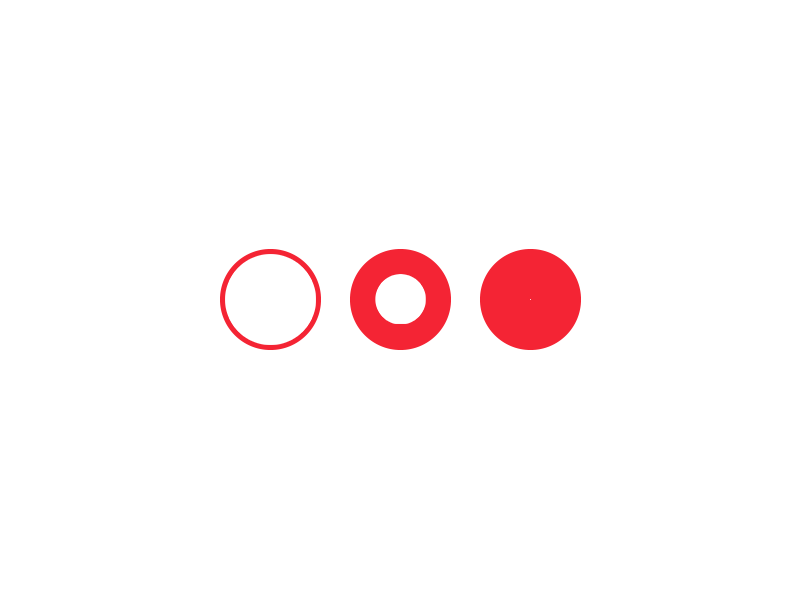
This page provides a selection of the specimens that have passed through the Fabre Minerals website and, due to their quality,
rarity, or significance as specimens from interesting locations, have been preserved as reference specimens in #MVM
It is a new species discovered and accepted by the IMA in the year 2005. It forms different growths, the most usual practically spherical forms, but also donut and empty hemispherical forms. This rare phosphate can be easily confused with another similar, also rare, species. So, we analyzed our samples and we’ll send a copy of the analysis to the buyer. The analytical process also confirmed that in some specimens the matrix is Beryllonite that, furthermore, appears as idiomorphic crystals which adds special interest to the specimen where it is present.
| Ruifrancoite with Childrenite and Quartz |
|
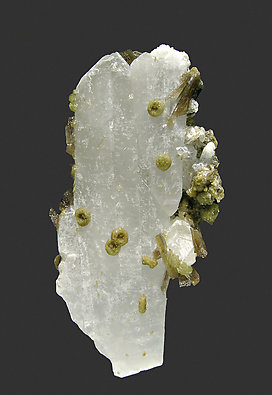 |
|
|
|
TA11J1: Donut-shaped isolated growths, green colored, on Quartz crystals and prisms of brown Childrenite.
Poço Dantas Mine, Piauí Valley, Taquaral, Itinga, Jequitinhonha, Minas Gerais Brazil (2006)
Specimen size: 4.9 × 2.7 × 2.6 cm = 1.93” × 1.06” × 1.02”
Main crystal size: 0.2 × 0.2 cm = 0.08” × 0.08”
|
|
|
|
Ruifrancoite with Beryllonite and Childrenite |
|---|
|
|
TE11J8: Small groups of yellow crystals that cover and are with brown prismatic crystals of Childrenite, on a matrix of Feldspar and with well-defined crystals of Beryllonite.
Poço Dantas Mine, Piauí Valley, Taquaral, Itinga, Jequitinhonha, Minas Gerais Brazil (2006)
Specimen size: 5 × 4.3 × 3.4 cm = 1.97” × 1.69” × 1.34”
Main crystal size: 0.1 × 0.1 cm = 0.04” × 0.04”
|
| |
|
| Ruifrancoite on Beryllonite and with Childrenite |
|
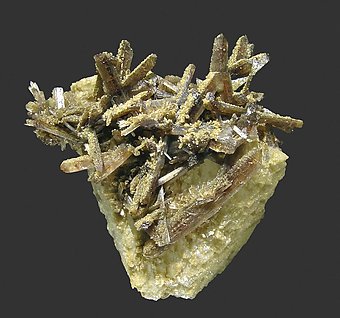
Front | 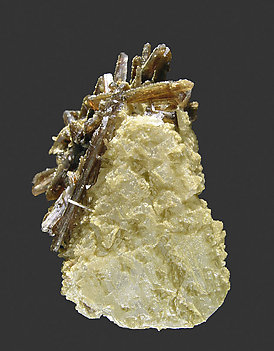
Side |
| |
|
|
|
|
TE14J1: Spherical green growths on a white, well-developed, crystal of Beryllonite, and with brown prisms of Childrenite.
Poço Dantas Mine, Piauí Valley, Taquaral, Itinga, Jequitinhonha, Minas Gerais Brazil (2006)
Specimen size: 5.1 × 4.3 × 2.8 cm = 2.01” × 1.69” × 1.10”
Main crystal size: 0.1 × 0.1 cm = 0.04” × 0.04”
|
|
|
The main talking point during the Ste. Marie 2004 show was the new Hematite with Rutile from Novo Horizonte, as it was the first time that they had been seen at a European show and they were a great success. They are spectacular, some of them were on matrix, and the Rutile crystals were thicker, stronger and better terminated than in previous finds means that this find will be talked about for years to come.
We always keep a look out for new material that appears in the mineral world, so this time we were able to carefully select some examples. We looked for ones that that were perfect had had strong Rutile crystals, thus avoiding later problems during shipping.
|
Rutile with Hematite |
|---|
|
|
MP66AN0: Star-shaped epitaxial growths of Rutile crystals, between acicular and finely prismatic, with very bright luster, yellow color with golden reflections, oriented according to the structure of tabular Hematite crystals.
We will ship the specimen in its original Perky box from the Robert J. Noble collection, which also contains the label.
Novo Horizonte, Bahia, Northeast Region Brazil
Specimen size: 2.4 × 2.3 × 2.1 cm = 0.94” × 0.91” × 0.83”
Former collection of Bob Noble
|
| |
|
| Hematite with Rutile |
|
|
|
|
|
MM96AM9: Floater group of Hematite crystals with very well defined faces and edges, lustrous, and with epitaxial growths of flattened Rutile crystals.
We will send the specimen, which comes from the Robert J. Noble collection, in its original Perky box from that collection, which also contains the label, which shows that it was previously in the Frank Melanson collection.
Novo Horizonte, Bahia, Northeast Region Brazil
Specimen size: 3 × 1.8 × 1.6 cm = 1.18” × 0.71” × 0.63”
Main crystal size: 1.4 × 1 cm = 0.55” × 0.39”
Former collection of Bob Noble
|
|
|
|
Rutile and Hematite |
|---|
|
|
EJ26F4: The crystals of Rutile, which are brilliant yellow and have golden reflections, have grown epitaxially on tabular Hematite. The terminations of the Rutile have very well defined faces, which is not so common with this type of specimen.
The specimen's photo has been reviewed and published in the magazine ‘Rocks & Minerals’ on page 174 in the volume 85, number 2.
Caí bom Mine, Novo Horizonte, Bahia, Northeast Region Brazil (02/2004)
Specimen size: 2.8 × 2.4 × 0.2 cm = 1.10” × 0.94” × 0.08”
|
| 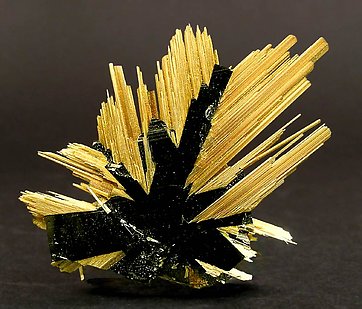
Front | 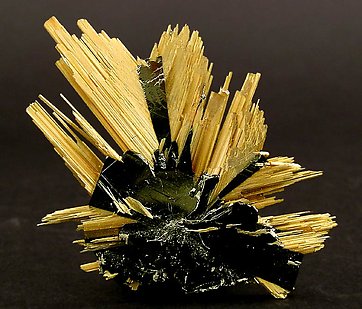
Rear |
| |
|
|
| Rutile and Hematite |
|
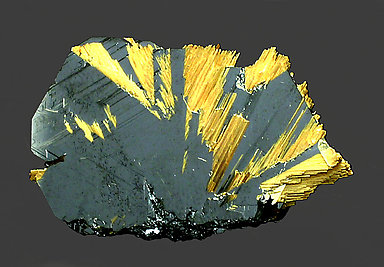
Front | 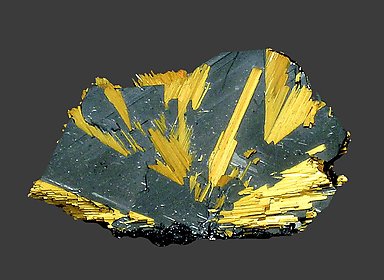
Rear |
| |
|
|
|
|
EB46E2: Thick, very brilliant, and perfect crystals of Hematite that formed as a floater and that has a re-crystallized base. The Rutile is growing in the typical orientation on its faces. A really luminous specimen.
Caí bom Mine, Novo Horizonte, Bahia, Northeast Region Brazil (02/04)
Specimen size: 3.8 × 2.4 × 0.5 cm = 1.50” × 0.94” × 0.20”
|
|
|
|
Rutile and Hematite |
|---|
|
|
ED86F1: Two crystals of Hematite, as well as some other smaller ones, that form the base for the growth of fine epitaxial prisms of Rutile, which are perfect defined and terminated and have the 60º angles between them that are dictated by the Hematite.
Caí bom Mine, Novo Horizonte, Bahia, Northeast Region Brazil (02/2004)
Specimen size: 4 × 3.5 × 3 cm = 1.57” × 1.38” × 1.18”
|
| |
|
| Rutile with Hematite |
|
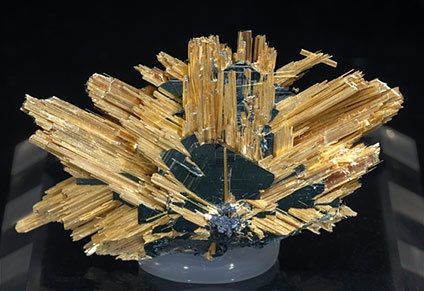
Front | 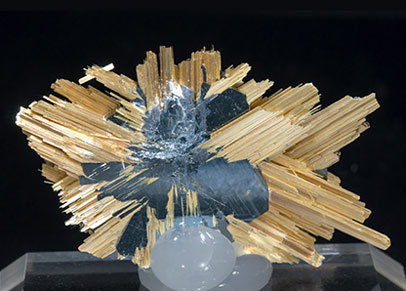
Rear |
| |
|
|
|
|
GB52AD4: Epitaxial growths on platy Hematite crystals of thin Rutile crystals with finely striated prismatic faces and good terminations. They have a golden color and are very bright. The sample is from the first finds of this type of Rutile from the locality.
Caí bom Mine, Novo Horizonte, Bahia, Northeast Region Brazil
Specimen size: 4.5 × 3 × 0.9 cm = 1.77” × 1.18” × 0.35”
Former collection of Pedro Goy
|
|
|
|
Rutile with Hematite |
|---|
Fluorescent light (daylight)
|
|
|
NFB27AP1: Epitaxial growths of acicular Rutile crystals, with very bright luster and golden reflections, on lamellar crystals of Hematite, and on matrix, something uncommon in this type of specimen.
Caí bom Mine, Novo Horizonte, Bahia, Northeast Region Brazil (±2007)
Specimen size: 4.6 × 3.4 × 2.7 cm = 1.81” × 1.34” × 1.06”
Main crystal size: 2.7 × 2.3 cm = 1.06” × 0.91”
|
| |
|
| Rutile with Hematite |
|
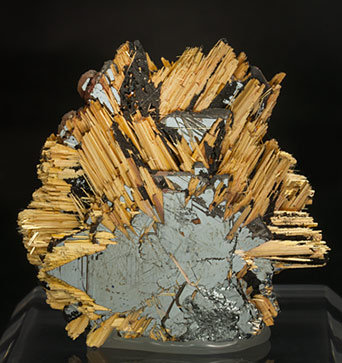
Front | 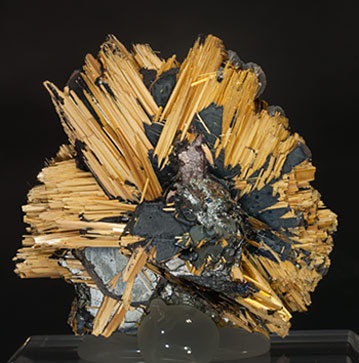
Rear |
| |
|
|
|
|
MC69AE6: Epitaxial overgrowths of needlelike rutile crystals on platy Hematite crystals. They have a yellow color with golden reflections, are very bright and have grown oriented in the shape of starbursts following the structure of the tabular Hematite crystal.
Caí bom Mine, Novo Horizonte, Bahia, Northeast Region Brazil
Specimen size: 4.7 × 4.2 × 2.4 cm = 1.85” × 1.65” × 0.94”
|
|
|
|
Rutile with Hematite |
|---|
Recorded under neon light
|
|
|
EFF70CDD: We've seen many pieces of this material, but just a few in matrix like this one, and also with the well-defined 'star' of Rutile-Hematite.
Caí bom Mine, Novo Horizonte, Bahia, Northeast Region Brazil
Specimen size: 4.7 × 4.5 × 1.9 cm = 1.85” × 1.77” × 0.75”
Main crystal size: 2 × 0.1 cm = 0.79” × 0.04”
|
| 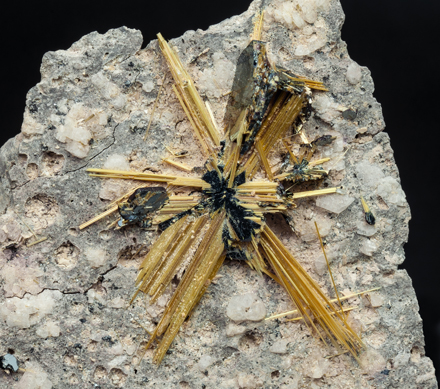 |
|
| Rutile with Hematite |
|
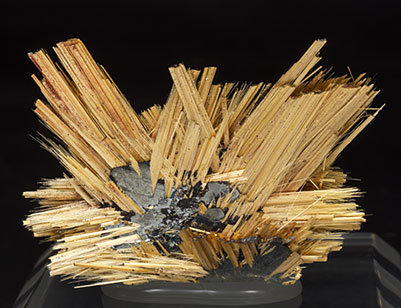
Front | 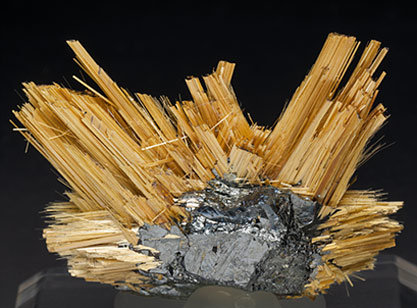
Rear |
| |
|
|
|
|
MD69AE6: Epitaxial overgrowths of needlelike rutile crystals on platy Hematite crystals. They have a yellow color with golden reflections, are very bright and have grown oriented in the shape of starbursts following the structure of the tabular Hematite crystal.
Caí bom Mine, Novo Horizonte, Bahia, Northeast Region Brazil
Specimen size: 4.9 × 3.8 × 1.7 cm = 1.93” × 1.50” × 0.67”
|
|
|
|
Quartz with Rutile and Hematite |
|---|
|
|
MF47L1: Very sharp Quartz crystal group, with acicular Rutile crystal inclusions. Rutile crystals are epitaxic on laminar Hematite, some of them included in the Quartz, some not. Very esthetic specimen.
Caí bom Mine, Novo Horizonte, Bahia, Northeast Region Brazil (07/2005)
Specimen size: 4.9 × 4.5 × 3.9 cm = 1.93” × 1.77” × 1.54”
Main crystal size: 3.7 × 2 cm = 1.46” × 0.79”
|
| 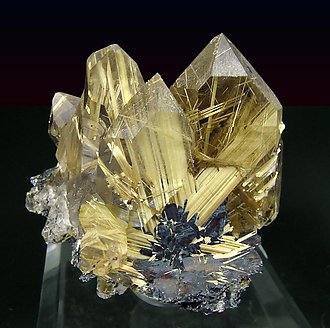
Front | 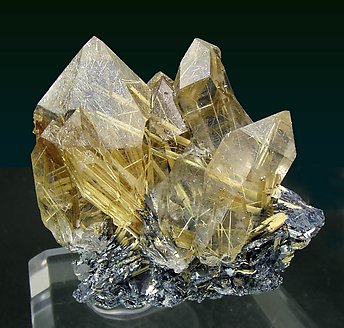
Rear |
| |
|
|
| Rutile with Hematite |
|
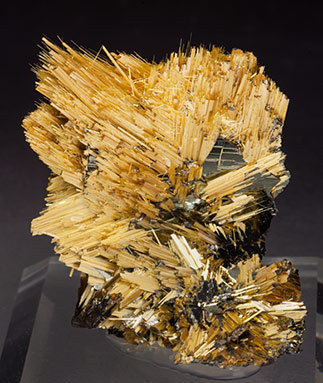
Front | 
Rear |
| |
|
|
|
|
ME49AE6: Epitaxial overgrowths of needlelike rutile crystals on platy Hematite crystals. They have a yellow color with golden reflections, are very bright and have grown oriented in the shape of starbursts following the structure of the tabular Hematite crystal.
Caí bom Mine, Novo Horizonte, Bahia, Northeast Region Brazil
Specimen size: 5 × 3.5 × 2.6 cm = 1.97” × 1.38” × 1.02”
|
|
|
From the famous gem Spessartine from Lavra do Navigador we are able to offer these specimens. We selected them primarily for their good transparency, and also when they have brilliant crystals that are well defined. We tried to avoid the ones that have a ‘dissolved’ look, which many of the ones from this find show.
|
Spessartine with Quartz |
|---|
|
|
MD16P6: Floater crystal of very well marked polycrystalline growths, etch dodecahedron faces and with a very small Quartz crystal. Color, luster and
transparency are excellent.
Navegadora claim (Orozimbo claim), Penha do Norte, Conselheiro Pena, Vale do Rio Doce, Minas Gerais Brazil (10-11/2006)
Specimen size: 1.9 × 1.6 × 1.3 cm = 0.75” × 0.63” × 0.51”
Main crystal size: 1.6 × 1.5 cm = 0.63” × 0.59”
|
| 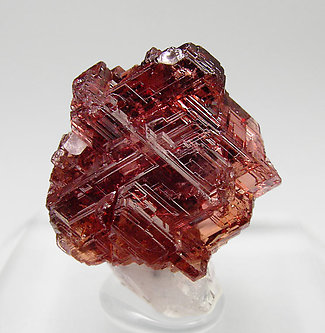
Front | 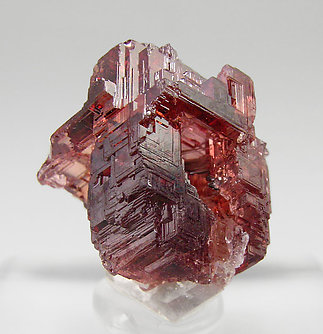
Rear |
| |
|
|
| Spessartine |
|
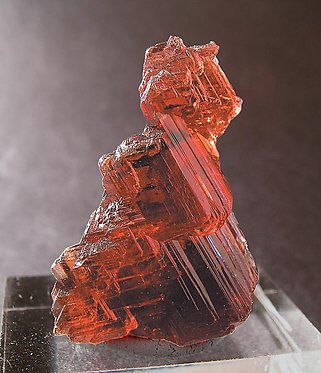 |
|
|
|
TM66E0:
Navegadora claim (Orozimbo claim), Penha do Norte, Conselheiro Pena, Vale do Rio Doce, Minas Gerais Brazil (2003)
Specimen size: 2.6 × 1.7 × 0.7 cm = 1.02” × 0.67” × 0.28”
|
|
|
|
Spessartine with Quartz |
|---|
|
|
TC86L1: Spessartine crystals, one of them dominant, very transparent, notable for their color intensity and extraordinary brilliance. With very marked stepped faces produced by etching. On a Quartz matrix, which is rare.
This specimen comes from the private collection of the well-known Wendy and Frank Melanson, from Canada.
Navegadora claim (Orozimbo claim), Penha do Norte, Conselheiro Pena, Vale do Rio Doce, Minas Gerais Brazil (10-11/2006)
Specimen size: 3 × 1.7 × 1.8 cm = 1.18” × 0.67” × 0.71”
Main crystal size: 1.6 × 1.4 cm = 0.63” × 0.55”
|
| 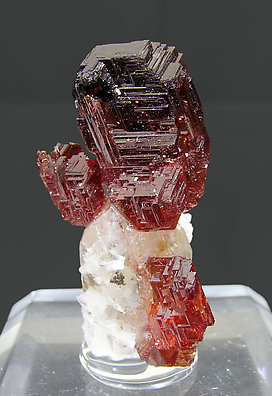 |
|
| Spessartine |
|
|
|
|
|
TV68Q8: A floater flattened dodecahedral crystal with parallel faces due to etching typical for the specimens from this locality. The crystal is transparent and has a very deep and uniform color that acquires a special quality under an intense light.
Navegadora claim (Orozimbo claim), Penha do Norte, Conselheiro Pena, Vale do Rio Doce, Minas Gerais Brazil (10-11/2006)
Specimen size: 4 × 2.7 × 1.9 cm = 1.57” × 1.06” × 0.75”
|
|
|
|
Spessartine with Albite |
|---|
|
|
TM36D8: From the famous find of gem Spessartine from Lavra do Navegadora we obtained this enormous crystal that shows of all the great features of the find. Intense color, great transparency, a floater, complete and with dissolution marks on its faces. In this piece, just to add to everything else, the brilliance is extraordinary and, even though it is quite thick, the gem quality of the crystal is very visible when lit from the front and spectacular when lit from the rear. There is a little bit of Albite on this powerful specimen.
Navegadora claim (Orozimbo claim), Penha do Norte, Conselheiro Pena, Vale do Rio Doce, Minas Gerais Brazil (2003)
Specimen size: 6.2 × 4.7 × 3.5 cm = 2.44” × 1.85” × 1.38”
|
| |
|
The color of these Variscites is extraordinary, deep red, and especially unusual for the species, placing them among the best known.
Analysis indicate these Variscites are slightly ferroan (which is normal considering that Al and Fe form a series). We think, however, its color is not due to iron because the center of crystals is almost uncolored but the external zone is deeply colored yet both zones have the same chemical composition. Considering all this we think the red color may be due to color centers as is the case of some zoned Fluorites.
As we normally do in these cases we will send the buyer a copy of the analysis.
| Variscite |
|
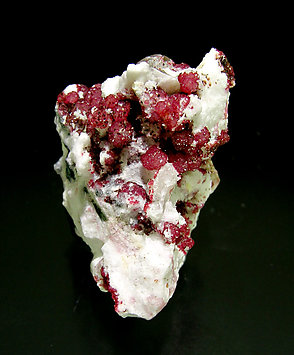
Front | 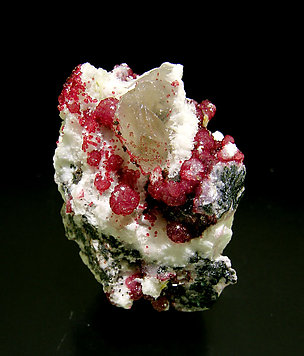
Rear |
| |
|
|
|
|
EK6H6: Crystals and spheroidal groups have very intense color and luster. They occupy the vugs on the sample and contrast with the matrix, clearer in some zones and darker in others.
The specimen has been reviewed, photographed and published as a new discovery in the magazine ‘Mineralogical Record’ on page 481 in the volume 37, number 5.
Boa Vista (Eduardo) Mine, Conselheiro Pena, Vale do Rio Doce, Minas Gerais Brazil (2006)
Specimen size: 2.1 × 1.5 × 1.8 cm = 0.83” × 0.59” × 0.71”
|
|
|
|
Variscite |
|---|
|
|
EG12H6: Crystals and spheroidal groups have very intense color and luster. They occupy the vugs on the sample and contrast with the matrix, clearer in some zones and darker in others.
Boa Vista (Eduardo) Mine, Conselheiro Pena, Vale do Rio Doce, Minas Gerais Brazil (2006)
Specimen size: 3.2 × 2.3 × 1.7 cm = 1.26” × 0.91” × 0.67”
|
| 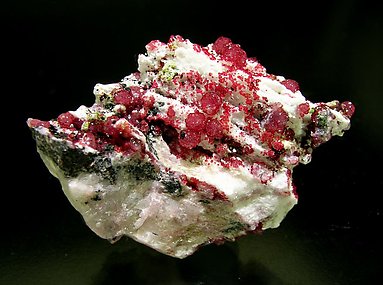
Front | 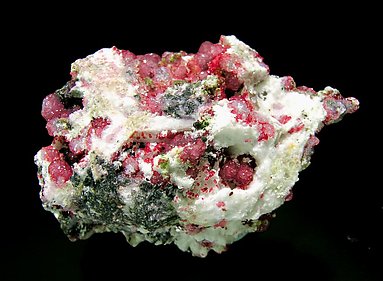
Rear |
| |
|
|
| Strengite |
|
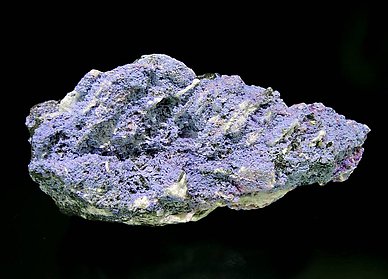 |
|
|
|
TR9H6: The sample is very rich with purlish Strengite concretions that occupy nearly all the specimen volume. Locally there are some small rows of Variscite crystals.
We’ll give a copy of the Strengite analysis to the buyer.
Boa Vista (Eduardo) Mine, Conselheiro Pena, Vale do Rio Doce, Minas Gerais Brazil (2006)
Specimen size: 6.6 × 3.4 × 3.8 cm = 2.60” × 1.34” × 1.50”
|
|
|
|
Zanazziite on Quartz (variety rose quartz) |
|---|
Fluorescent light (daylight)
|
|
|
EBP66AP3: Spheroidal aggregates of Zanazziite microcrystals with a greenish brown color on a group of Quartz crystals (pink quartz variety) that has grown on an isolated crystal of white Quartz.
This specimen comes from the type locality for the species.
Ilha claim, Taquaral, Itinga, Jequitinhonha, Minas Gerais Brazil
Specimen size: 4.6 × 2.6 × 1.6 cm = 1.81” × 1.02” × 0.63”
Main crystal size: 0.1 × 0.1 cm = 0.04” × 0.04”
Type locality
With analysis copy
|
| |
|
| Zanazziite with Muscovite and Quartz |
|
|
|
|
|
TF27AM7: Coatings of many small salmon-colored Zanazziite crystals with good luster, on a Muscovite matrix with Quartz crystals.
Murundu Mine, Jenipapo District, Itinga, Jequitinhonha, Minas Gerais Brazil
Specimen size: 9.4 × 7.2 × 4.7 cm = 3.70” × 2.83” × 1.85”
Main crystal size: 0.1 × 0.1 cm = 0.04” × 0.04”
|
|
|
|
Zanazziite with Elbaite and Microcline |
|---|
Fluorescent light (daylight)
|
|
|
TFR96AO4: Spheroidal aggregates of Zanazziite microcrystals, a rare phosphate of calcium, magnesium and beryllium, translucent, lustrous, and light cream in color. On matrix with Elbaite crystals and small Microcline coatings.
Ponte do Piauí Mine, Piauí Valley, Taquaral, Itinga, Jequitinhonha, Minas Gerais Brazil
Specimen size: 9.9 × 4.6 × 3.7 cm = 3.90” × 1.81” × 1.46”
|
| |
|
| Zanazziite (manganoan) with Kosnarite and Albite |
|
|
|
|
|
TK6K9: On the same specimen there are two very rare species. Beige crystals of Kosnarite with pinkish, radial aggregates of Zanazziite, on white Albite matrix. The Zanazziite has been carefully analyzed and the result is surprising: iron is nearly replaced by manganese (thus its pinkish shade), so we present it as manganoan Zanazziite. Matrix is Albite. We’ll send a copy of the analysis to the buyer.
Jenipapo District, Itinga, Jequitinhonha, Minas Gerais Brazil (2002-2003)
Specimen size: 4.6 × 1.9 × 2.2 cm = 1.81” × 0.75” × 0.87”
Main crystal size: 0.1 × 0.1 cm = 0.04” × 0.04”
With analysis copy
Minor fluorescence UV short wave
|
|
|
|
Zanazziite (manganoan) with Kosnarite and Albite |
|---|
|
|
TE96H4: On the same specimen there are two very rare species. Kosnarite in pseudo-octahedral, creamy, crystals with very sharp and bright faces and edges. The Zanazziite has been carefully analyzed and the result is surprising: iron is nearly replaced by manganese (thus its pinkish shade), so we present it as manganoan Zanazziite. Matrix is Albite. We’ll send a copy of the analysis to the buyer.
Jenipapo District, Itinga, Jequitinhonha, Minas Gerais Brazil (2002-2003)
Specimen size: 6.4 × 5.6 × 6.1 cm = 2.52” × 2.20” × 2.40”
Main crystal size: 0.1 × 0.1 cm = 0.04” × 0.04”
Fluorescent short UV
|
| |
|
| Zanazziite (manganoan) with Albite and Elbaite |
|
|
|
|
|
TG46AM5: Polycrystalline radial aggregates of Zanazziite, a rare phosphate of calcium, magnesium, and beryllium, translucent and pink and on an Albite matrix with Elbaite crystals. The analysis, of which we will send a copy to the buyer, shows an almost complete substitution of manganese for the normal subordinate iron, which is why we call it manganese-rich Zanazziite.
Jenipapo District, Itinga, Jequitinhonha, Minas Gerais Brazil (2002-2003)
Specimen size: 6.9 × 5.4 × 4.2 cm = 2.72” × 2.13” × 1.65”
Main crystal size: 0.1 × 0.1 cm = 0.04” × 0.04”
|
|
|
| |
Previous Page   Next Page Next Page |
 |
|
|
| |
| All pictures, text, design © Fabre Minerals 1996-2024 — Europe's first Internet mineral dealer, on the web since 1996 |
|






